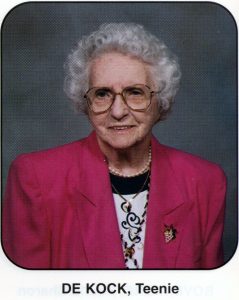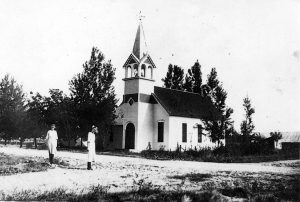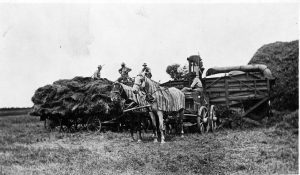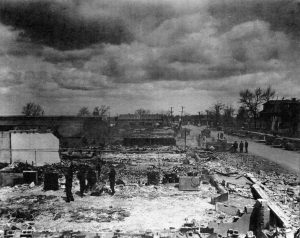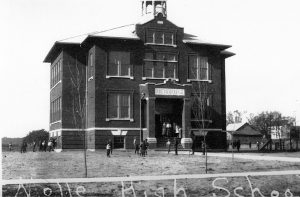Teenie DeKock
THE SETTLING OF THE GRAND MARSH OF THE KANKAKEE RIVER
Interview by Laverne Terpstra, Transcribed by Shirley Zeck
April 13, 1993
I was born two miles south of the Dutch Church. I was born there and lived there until I was about four and then we moved over to where SR 110 is now; up there on a sand hill. It was all sand, everywhere.
I lived there until I was seven. Then my folks built a new place three miles east of Thayer. My brother (Henry) still lives there.
I went to school at the Shortridge School which was over there by the sand hill. We went to the Miller School in Thayer, which was a mile from where we lived. That was all walking. Of course, that was horse and buggy days, too. Then for one year in the seventh grade I went to Thayer. From there they transferred us to DeMotte to the big school there. I went to the Morning Star School, too. That was where Larry Post now lives. That’s my education.
I was born in 1908, February 25. I just celebrated my 85th birthday.
Some of the hardships when I grew up were we didn’t have doctors around and hospitals and all that. Of course, we knew nothing of hospitals at that time. The doctor came to the house or you went to the office. That was old Dr. Tate in Thayer. He was a good old faithful fellow.
Dentists? There weren’t any dentists. You just went to a regular doctor. You didn’t know what it was to have a tooth filled or anything. I can remember my Dad hanging on to my head and the doctor pulling on my teeth. There was no anesthetic, novocaine, or whatever they used in those days. It was a pretty painful thing.
The main outdoor chore we did was milk cows, morning and night. And then we worked out in the field picking pickles and shocking grain and hoeing and that kind of stuff.
In the house, of course, we girls had our own housework to do, as normal; of course not with the conveniences we have today. I can remember washing. That was just in a kind of summer kitchen. Then we had to put the water in the old boiler and get that all good and hot first. Then we pushed the machine by hand like everybody else did in those days.
My dad took care of the garden. I didn’t have anything to do with that. I helped pump the water for the wash. It was an all day job by the time you got the hot water and would bring it out to another shed into the washer then work it by hand. Then it was put out on the line no matter what the weather was.
Then of course, ironing was different, too. You would put the iron on the old cookstove and let the flatirons get hot. Then you would iron with that. We really ironed more in those days than we do today because everything had to be starched in those days; pillowcases and everything. I can remember starching everything.
We were always canning. We didn’t buy cans. My mother baked bread.
Threshing was a big day. Men would come and expect a lot of food, too. There was a lot of cooking and a lot of work. But it was kind of fun anyway. I can remember one fellow came and it seemed he always had to have pie.
So, he said he was going to eat his pie first because he said he was afraid he would be too full. Anyway, they had their own ideas, I guess.
We canned meat because there was no way to keep fresh meat. We had an old outdoor cellar and that’s where we did keep a lot of vegetables. That’s where everything else was carried to, also, you know. It was down in the ground. I don’t remember a smokehouse.
We played games a lot at night. The neighbors came over.
They all had kids. At that time Ostings were living there and Walstras and Sekemas and all of them. We played pum pum pull away and hide and go seek and all of that kind of stuff. At Christmas we all had one toy. The girls mostly got dolls and my parents would take and hide them before Christmas. Then the next morning we would be up on time and have to find them ourself. But we were more satisfied with one doll than how many they have to have today to please them.
We girls learned to sew quite young and then I had a sister- in-law that did a lot of our sewing. So, it was all by hand. We were pretty proud of a new dress you know if we went to school. You didn’t have that many dresses, one Sunday one and one to go to school.
I can remember when we lived over there on the sandhill there was always a sort of cyclone. cyclones were pretty common at that time. We had an outdoor storm cellar or whatever you want to call it. That’s where we had to go.
In those days too, I can remember if a storm came during the night we all had to get up and get dressed. And if it was cold in the winter and it was bad weather we all sat around the stove. We all had to come from upstairs. We couldn’t stay up there.
My parents talked Dutch when I was young. My dad insisted that we talk back to him in Dutch, too. Finally, he got a little more used to us speaking the language among ourselves. (The English language). I think newspapers had something to do with it too. He got away from that idea that we didn’t have to talk Dutch all the time. All of us could talk well except my two younger sisters. They didn’t get along too well, but the rest of us could talk Dutch.
I’m a Gronegin, I can understand that. We went to Europe to my uncle and aunts. Of course, they didn’t know one word of English.
That worried her that we were going to be there and how was she ever going to talk to her niece. But we were there and by ten or eleven o’clock at night we were going pretty strong. It had all come back to me. Ralph could talk Dutch really better than I could.
Most of the kids’ diseases were measles, chicken pox, and whooping cough. A lot of the kids had whooping cough. There was diphtheria. That was serious. You were quarantined and not allowed to ship milk either. Smallpox—I can remember that. We were quarantined then, too.
I can remember the old kraut factory. That was along the tracks west of town.
And of course at that time being in school, we girls had a basketball team. But there was no gym to play in so we used that kraut factory. I guess the boys used that as theirs also.
Then for a time, the boys played upstairs over down here on division Street. That’s where they played. But I can remember playing in the kraut factory.
Then they had the pickle factory east of town. I think the building is still there. They used it a while for KV Electric, I think, for insulation. That was it.
I don’t remember too much about the cheese factory. I can remember the International. Ralph was in the International business. They didn’t have a building either. Of course, that was all horsedrawn stuff, anyway.
They had a grocery store uptown too. Upstairs is where they kept the parts department for the implements. Later on we moved across the tracks where the garage is now. Then of course, it became more motorized, more tractors and that kind of stuff. It’s that garage right by the railroad tracks. It used to be Neil Sekema’s garage (713 Halleck St. S.E.). That’s where we were in business to begin with.
Case DeKock had the grocery store downstairs and then he got his boys in with him by the time I married. I went to work there when I graduated from high school in the grocery department. That’s when they still had the parts upstairs.
Later, the implement business moved across the tracks. People did a lot of trading, horses, etc for implements. Later on in 1946 we moved along the highway which is now Thomas’
Carpet Place (808 15th St. S.E.)
When I married we were in the grocery business. Hank got the hardware but they all seemed to work together.
Then we had the big fire. We soon got a new store after that, like everybody else. In those days we had competition. There were three grocery stores right up town.
We were in the middle and Bill Swart was on the end. Before he was in there Hank Swart was there (Sam Kingma’s in- laws, Marsha). Then a Kooy was right in the middle of town. We had a lot of competition. Ed DeBruin went on the end where Cheevers are now.
In those days they had the creamery too. We had that in the grocery store. They brought in their cream and we tested it in there. They brought chickens and eggs. It was all connected with the grocery store.
We worked hard, I think. Of course, in those days you had to put up the groceries. It wasn’t like when you wait on yourself. You wrote the groceries first. It was mostly men that did the shopping and they came from home with their little slip of paper and we would write it down. Then we would chase all over and put it up.
Then we stayed open on Wednesday nights until about 10:30. Saturday nights we were always open until 11:30. This was because there were a few people who came to town and enjoyed sitting in their car and watching the people parade back and forth down the street. They forgot about us. We wanted to go home. Then they would come in and still want their groceries. It was certainly different.
In those days we had the meat department in the store. But it was Ralph who had to go out in the country to buy the cattle and pigs to butcher. We had a slaughter house east of town. So he always did the slaughtering too.
Sometimes he had to work behind the counter. But he’d rather be outside than behind the counter in the store. That’s where our fresh meat always came from. It was located where Walstra’s or Harvey Kamminga have their business (832 15th St. S.E.). It had no refrigeration like today with the freezers and all. They would kill enough for a few days at a time. They hung it up for so long, then they would bring it in to town to the coolers.
I didn’t know the one hotel. I just heard it was the Troxell Hotel. It was located where Rudy Zylstra’s station is now (713 Halleck St. S.E.). When I knew it was the DeKock house. They lived there with their family.
The other hotel, later on was the Halleck Hotel. That was up on the corner right in town where the new memorial is built (Southeast corner of 8th Pl & Halleck). There is a parking lot there now and also Konovsky’s house. That was the hotel in town.
It was a big place. They had a family of boys and girls. There was a Ransom. He finally died because of TB. That was popular at that time, too. I remember Grace, Opal and Edna. They were relatives of Charles Halleck. Our main street is named after him.
I can remember Konovsky’s had a building right west of where Holley’s Restaurant now is (804 S. Halleck). They had an upstairs to that. In there they had a theatre. We went to the movies every once in a while (silent movies). But I can remember they had a big program and everything when I graduated from the eighth grade.
The high school even had graduation there at that time because I can remember the one and only person at that time that graduated. I think it was an Osterhoff. Buy it was the movies we enjoyed up there.
Later on they played basketball in the building that Fagens have (915 S. Halleck). That’s where the independents had a good team, too. They played basketball in there and then they would run across the street to the school to take their showers. Whether it was cold or not that’s where they went.
We had programs there also and graduation. I think we had a high school band by that time. We had school plays and I was involved in them. We had baccalaureate and we had good programs and speakers.
We always had a good band in school. I wasn’t one of them but we had good activities in school. In comparison we did pretty well, I think with what we had.
At the Morning Star school (10640 W. 1200 N.), Bert Llewellyn was my teacher. It was a one room school with eight grades. Later he was in the school in DeMotte. He was a bachelor, pretty popular at that time.
We had a lady principal, Maggy Marshal. She was very strict. Later on we had Al Ewart. I graduated from high school in 1925. There were ten in my class, five boys and five girls.
Then, if you went to Valparaiso University for twelve weeks in the summertime you were a school teacher. But I never had that opportunity. I didn’t have the money and you didn’t borrow money in those days. I just never got to be a teacher. But that was really my ambition.
Gladys Ewart was one of them that went to that school and also Beulah Hart. In later years they got more edeucation, of course. But at that time that’s all you needed.
My classmates were Minnie Dexter, Elizabeth Hammerton, Gene and Carolyn Hanford (twins), Jim Coberly, Bill Swart (Preacher Peter Swart’s son), and Sam Kingma. There were five girls I know. That was in 1925.
This concludes the interview with Teenie DeKock.


